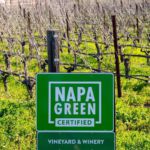
Climate positive (carbon negative) goals in Napa and Sonoma vineyards
Photo GETTY
How Napa And Sonoma Vineyards Are Going Beyond Sustainability To Embrace Climate Positive Goals
- FORBES | Liz Thach, MW |
- September 8, 2021
California wineries have long been leaders in environmentally friendly practices, because they recognized early on that wine grapes are one of the most susceptible crops to global warming. Indeed by 2019, 99% of Sonoma County vineyards were certified sustainable and 94% of Napa vineyards and wineries achieved certification under the Napa Green program. However, now both counties have established even more aggressive goals to reduce their carbon footprint and become climate positive – which is beyond carbon neutral, with negative emission reductions.
The sustainability certifications the vineyards achieved focused on efforts to improve the environment, employee working conditions, and economics – also referred to as planet, people and profits. Certifications were provided by third-party organization such as California Sustainable Winegrowing Alliance, Napa Green, and Fish Friendly Farming. However with so much progress, sustainability has become a new baseline for moving forward.
“Any continued actions we can take to reduce energy use in the vineyard and wineries will help to reduce our carbon footprint,” reports Anna Brittain, Executive Director for Napa Green. With this in mind, Napa Green has set a goal to work with certified growers to become carbon neutral within six years (2027), and carbon negative, or climate positive, within nine years (2030).
Sonoma County has also adopted a similar program called the Climate Adaption Certification Program. “We launched this program in 2020,” states Karissa Kruse, President of Sonoma County Winegrowers, and are working with local vineyards to administer best practices to maximize the sequestration of carbon emissions.” Some of these practices include reduced tilling of the soil, as well as planting more native shrubs around vineyards.
These efforts couldn’t come sooner, because the recent UN Climate Report has confirmed that global warming of 1.5°C to 2°C will occur as soon as 2040 if the world doesn’t take actions to reduce carbon (CO2) emissions soon. The results of global warming have already been witnessed in the increase in severe weather patterns such as wildfires, floods, and extreme frost/heat events that negatively impact agriculture. According to the EPA, the most effective way to reduce CO2 is to reduce fossil fuel consumption. It is also possible to sequester CO2 in the earth by planting more trees, plants, and cover crops.
BUT WHAT IS THE CARBON FOOTPRINT OF WINE?
Several studies have been conducted on the carbon footprint of the global wine industry, and it turns out that farming of vineyards produces very little CO2 and other greenhouse gases. One study assumed that fertilizers used in the vineyard would be a big contributor, but compared to other agriculture, vineyards use very little fertilizer. Indeed, according to Kruse, “In California, all of agriculture, including livestock operations, produces only 8% of the state’s greenhouse gas (GHG) emissions.”
Instead it is the transportation of wine that is the biggest culprit, as well as gas-operated tractors in the vineyard and energy use in the winery. According to a 2021 Italian wine study, the main contributors of greenhouse gas emissions for wine are: the glass bottle (29%), electricity in the winery (14%), transport and distribution of wine to the consumer (13%), heat used in the winery (9%) and fossil fuels used in vineyard (8%).
Because of this, efforts in the vineyard are focusing on reducing the number of passes a tractor must make through the vines, as well as adopting regenerative farming practices that include less tilling of the soil. This will not only reduce fossil fuels used in the vineyard, but the cover crop will allow vineyards to sequester carbon. In this way, vineyards represent “low hanging fruit” to become carbon negative, or climate positive.
Efforts to reduce energy usage in the winery are also underway, but will take more time. “Doing a full-scale carbon footprint inventory for a winery is very complicated,” states Brittan, “but we have some wineries who are also working on this. They are focusing on reducing bottle weight and other packaging modification, as well as installing solar, tracking waste, and implementing other energy and water saving mechanisms.”
COMMENDABLE EFFORTS AND GOALS OF NAPA/SONOMA WINERIES
Individual wineries in Napa and Sonoma are also taking other actions towards becoming climate positive. Joe Nielsen, Director of Winemaking at Ram’s Gate Winery in Sonoma County has decided to convert their vineyards from certified sustainable to organic. “We decided to bring in sheep to eat the weeds in the vineyard to reduce the number of times the tractor has to pass through the vines to spray herbicides ,” he said. “We are also investigating the use of electronic tractors, rather than gas powered ones.”
At Quintessa Winery in Napa Valley, they have just become certified in both Organic and Biodynamic vineyard operations. “We have been certified sustainable for many years,” reports Rebekah Wineburg, Quintessa Winemaker. “But this year we completed the formal 3-year certification process with CCOF and Demeter. We also have a philosophy to maintain as many of the native oaks and shrubs as possible to sequester carbon.”
Other wineries are making positive efforts to reduce water usage and the energy associated with pumping it into the vineyards and winery operations. Hope Goldie, Winemaker at Darioush in Napa Valley states, “We are reducing leaf removal in the vineyards and using micro emitters below the canopy to spray as minimal amount of water as possible, but still help the vines stay healthy and survive the drought.”
At Chandon Napa Valley, they are also reducing water by converting all of their landscaping to drought tolerant plants. “For the next two years we are embarking on a huge renovation to our grounds and the winery to reduce our water and energy usage,” states Pauline Lhote, Winemaking Director at Chandon. “Our company has also been working to reduce the weight of our bottles, which is one of the biggest contributors to wine’s carbon footprint. So far we have managed to reduce it by 25%, which means less weight in transportation to customers and therefore less use of fossil fuels.”
Two of the largest wineries in Napa and Sonoma have set aggressive goals to become climate positive. Jackson Family Wines, owners of Kendall-Jackson, Cardinale, La Crema and many other brands has just set a goal to cut their carbon footprint in half by 2030 and become climate positive by 2050. Treasury Wine Estates, owner of Beringer, Chateau St. Jean and many other brands has set a corporate goal to achieve net zero emissions by 2030.
Other Napa/Sonoma vineyards and wineries that have made progress towards climate positive goals include Benziger, Dutton Ranch, Spottswoode, Larkmead, Cakebread, Raymond, Chimney Rock, and Protector Cellars, amongst others.
ABOUT Liz Thach, MW

I am a freelance wine writer, wine market expert, researcher, educator and consultant based in Napa and Sonoma, California. As an award-winning author and educator, I specialize in wine business strategy, marketing, leadership/executive development, and wine lifestyle. My passion is wine, and I have visited most of the major wine regions of the world and more than 50 countries. My publications number over 200 articles and 9 books, including Call of the Vine, Best Practices in Global Wine Tourism and Luxury Wine Marketing. I completed my Ph.D. at Texas A&M University in Human Resources, and became a Master of Wine (MW) in May 2011, after passing the most rigorous wine exam in the world. In my free time, I enjoy hiking, golf, reading, and wine dinners with family and friends, as well as serving on several non-profit wine boards and being a wine judge.
Making the commitment to third party certification takes time and effort, but it is worth it to demonstrate our commitment to the community and to protect our watershed, our land and the air we breathe.
- Susan Boswell, Chateau Boswell Winery


